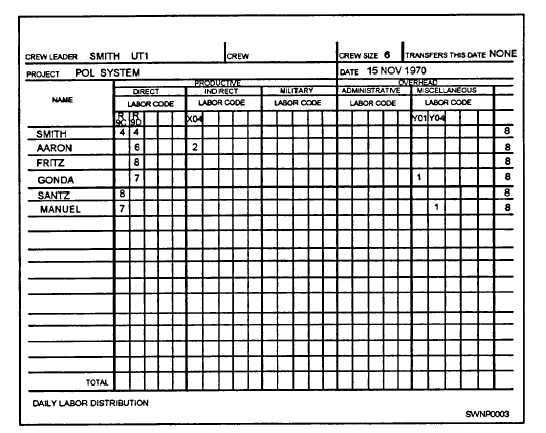
Figure 1-4. - Typical timekeeping card.
day on any given project. It is reviewed at the company level by the staff and platoon commander and then initialed by the company commander before it is forwarded to the operations department. It is tabulated by the management division of the operations department, along with all of the daily labor distribution reports received from each company and department in the unit. This report is the means by which the operations office analyzes the labor distribution of total manpower resources for each day. It also serves as feeder information for preparation of the monthly operations report and any other source reports required of the unit. This information must be accurate and timely. Each level in the company organization should review the report for an analysis of its own internal construction management and performance.
PERSONNEL READINESS CAPABILITY PROGRAM
The Personnel Readiness Capability Program (PRCP) was developed for use within the Naval Construction Force (NCF). The PRCP is based upon skill inventories of personnel and provides personnel information to all levels of management within the NCF. 'Ibis increases the ability of management to control, to plan, and to make decisions concerning the readiness of each unit. The PRCP is also used to identify the rating skills required and to determine the formal training and individual skills required by the Naval Facilities Engineering Command. Figure 1-5 is an example of a PRCP.
NAVFAC P-458
Guidance for the PRCP has been published in a one volume publication, NAVFAC P-458, to ease its use by staff personnel and PRCP interviewers. The PRCP contains standard skill definitions applicable to the NCF, Standards and Guides, that consist of seven separate manuals (one for each Seabee rating), and is the primary tool of the interviewer in collecting and updating data.
KILL INVENTORIES
An accurate and current skill inventory is the backbone of PRCP. Without this information, any planning done would be questionable. The PRCP is
Continue Reading